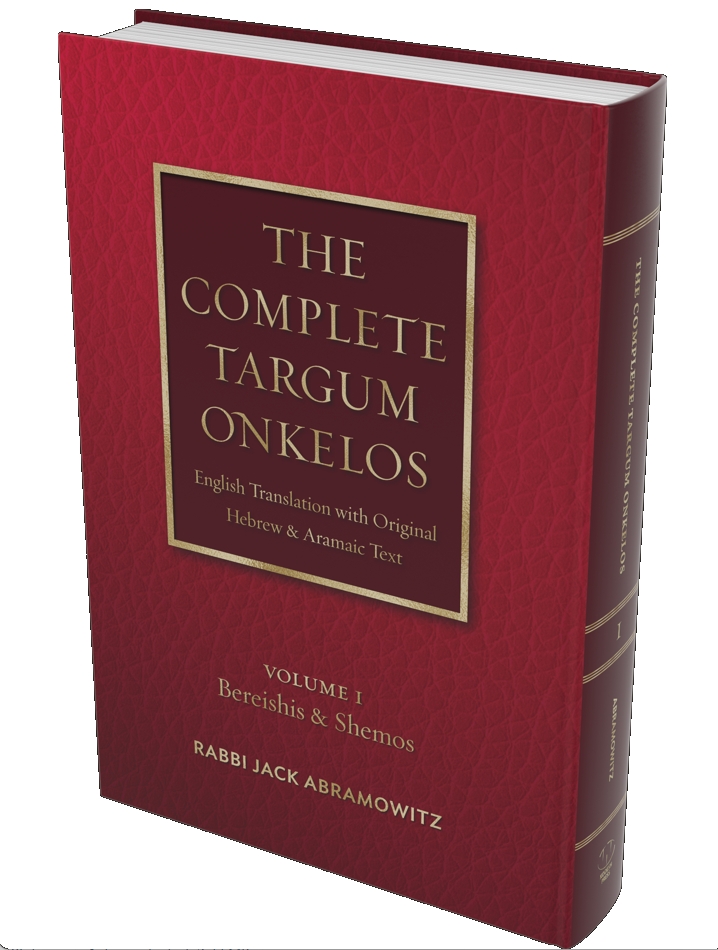All About Targum Onkelos
What’s So Special About Targum Onkelos?
Many people misunderstand the importance of Targum Onkelos, considering it to be “just” an Aramaic translation of the Torah. Targum Onkelos is actually so much more. This is testified to by the very fact that the Sages of the Talmud called for its inclusion when reviewing the weekly Torah portion!
The Targum is popularly attributed to a second-century convert named Onkelos, often identified as Aquilas, the nephew of the emperor Titus. Along with Rashi, Targum Onkelos is considered the commentary par excellence on the Torah. It’s much more than a mere translation; Onkelos actually sheds new light on the meaning of the verses.
While the Targum is renowned for its “p’shat” approach (referring to the simple or literal meaning of the text), Onkelos actually deviates from p’shat more than 10,000 times in an effort to clarify the meaning of the verses. The most famous of these perhaps are the great lengths that Onkelos takes to avoid anthropomorphisms that might suggest physicality on the part of God.
The Talmud in Megillah (3a) teaches us that the Targum of the Torah was written by Onkelos, based on what he learned from Rabbi Eliezer and Rabbi Yehoshua. The Gemara subsequently asks, based on a verse from Nehemiah (8:8 – “They read in the book, the Torah of Hashem, clearly; they gave the sense and caused them to understand the reading”), that the Targum was actually written in the days of Ezra, centuries before the time of Onkelos. The Gemara concludes that the Torah was originally adapted into Aramaic in the time of Ezra but it was forgotten by the majority of the people. The tradition of the translation was passed down to Rabbi Eliezer and Rabbi Yehoshua. They taught it to Onkelos, who reconstructed it for the Jewish people.
Using Rashi Instead of Targum Onkelos
As noted, the Sages instituted that the weekly Torah portion be reviewed along with Aramaic translation of Onkelos, even on verses like “Ataros and Divon,” i.e., proper nouns that have no translation. From this, we can easily infer the high regard in which Chazal held this particular work. Nevertheless, as we live in a society in which Aramaic is no longer the lingua franca of the Jewish people, the average person may not be able to get out of Targum Onkelos that which our Sages intended. Accordingly, many Rishonim maintained that if one were to review a commentary like Rashi in lieu of the Targum, then one would be able to fulfill the intention of the obligation.
There are, however, authorities like Rav Amram Gaon who strongly favor the use of Targum Onkelos due to its place in our Oral tradition (Biur Halacha OC 285:2). Additionally, while there may not be Aramaic translation on verses like “Ataros and Divon,” there is Targum Onkelos on every verse of the Torah. Such is not the case for commentaries like Rashi, which do not appear on every pasuk. The result is that one who reviews Shnayim Mikra v’Echad Targum using Onkelos actually reviews every verse three times, which one who reviews Shnayim Mikra v’Echad Targum using Rashi does not.
As noted in part 1, the Shulchan Aruch (OC 285:3) rules Rashi an acceptable substitute for Targum Onkelos, albeit preferring that one review both commentaries. Given time constraints, the halachic consensus is to give priority to the review of Rashi (Bi’ur Halacha 285:2 again).
May Any Other Commentaries Be Used?
Tosfos on Brachos 8a (s.v. Shnayim Mikra) discuss the question of reviewing Shnayim Mikra v’Echad Targum using a translation other than Onkelos. They write:
"Some explain that the requirement applies to foreigners in their own languages just like the Targum that explains the verses. Just as the Targum explains to unlearned people, foreigners likewise understand their own languages. Nevertheless, this is not correct because the Targum explains things that can’t be grasped from the Hebrew, as we see in many places. Rabbi Yoseif said (Megillah 3a), 'If not for the Targum on this verse, I wouldn’t understand what it was speaking about.' Therefore, one should not review the Torah portion for the third time using any other than the Targum."
We see once again that the value of Targum Onkelos far exceeds its surface appearance as a simple translation. Accordingly, the halachic consensus is not to rely on any other translation in order to fulfill the obligation of Shnayim Mikra v’Echad Targum, though one might rely on a translation of Rashi into another language, such as English (MB 285:4-5).
It’s noteworthy that the Taz and other authorities allowed German/Yiddish speakers to fulfill their obligation in Shnayim Mikra v’Echad Targum by reviewing Tzenah u’Renah, a 16th-century work by Rav Yaakov ben Yitzchak Ashkenazi. (See, for example, Mishnah Brurah 285:5.) Rav Osher Weiss permits one to use Targum Yonason, though maintaining that Targum Onkelos remains preferable.
The Complete Targum Onkelos
Volume 1: Bereishis and Shemos on Amazon and from Kodesh Press!
Volume 2: Vayikra, Bamidbar and Devarim on Amazon and Kodesh Press!
Two-volume set on Kodesh Press!

